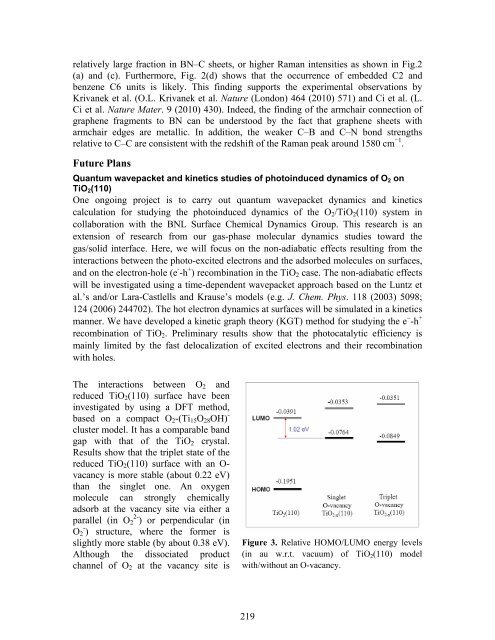Eighth Condensed Phase and Interfacial Molecular Science (CPIMS)
Eighth Condensed Phase and Interfacial Molecular Science (CPIMS)
Eighth Condensed Phase and Interfacial Molecular Science (CPIMS)
Create successful ePaper yourself
Turn your PDF publications into a flip-book with our unique Google optimized e-Paper software.
elatively large fraction in BN–C sheets, or higher Raman intensities as shown in Fig.2<br />
(a) <strong>and</strong> (c). Furthermore, Fig. 2(d) shows that the occurrence of embedded C2 <strong>and</strong><br />
benzene C6 units is likely. This finding supports the experimental observations by<br />
Krivanek et al. (O.L. Krivanek et al. Nature (London) 464 (2010) 571) <strong>and</strong> Ci et al. (L.<br />
Ci et al. Nature Mater. 9 (2010) 430). Indeed, the finding of the armchair connection of<br />
graphene fragments to BN can be understood by the fact that graphene sheets with<br />
armchair edges are metallic. In addition, the weaker C–B <strong>and</strong> C–N bond strengths<br />
relative to C–C are consistent with the redshift of the Raman peak around 1580 cm −1 .<br />
Future Plans<br />
Quantum wavepacket <strong>and</strong> kinetics studies of photoinduced dynamics of O2 on<br />
TiO2(110)<br />
One ongoing project is to carry out quantum wavepacket dynamics <strong>and</strong> kinetics<br />
calculation for studying the photoinduced dynamics of the O2/TiO2(110) system in<br />
collaboration with the BNL Surface Chemical Dynamics Group. This research is an<br />
extension of research from our gas-phase molecular dynamics studies toward the<br />
gas/solid interface. Here, we will focus on the non-adiabatic effects resulting from the<br />
interactions between the photo-excited electrons <strong>and</strong> the adsorbed molecules on surfaces,<br />
<strong>and</strong> on the electron-hole (e - -h + ) recombination in the TiO2 case. The non-adiabatic effects<br />
will be investigated using a time-dependent wavepacket approach based on the Luntz et<br />
al.’s <strong>and</strong>/or Lara-Castlells <strong>and</strong> Krause’s models (e.g. J. Chem. Phys. 118 (2003) 5098;<br />
124 (2006) 244702). The hot electron dynamics at surfaces will be simulated in a kinetics<br />
manner. We have developed a kinetic graph theory (KGT) method for studying the e � -h +<br />
recombination of TiO2. Preliminary results show that the photocatalytic efficiency is<br />
mainly limited by the fast delocalization of excited electrons <strong>and</strong> their recombination<br />
with holes.<br />
The interactions between O2 <strong>and</strong><br />
reduced TiO2(110) surface have been<br />
investigated by using a DFT method,<br />
based on a compact O2-(Ti15O28OH) -<br />
cluster model. It has a comparable b<strong>and</strong><br />
gap with that of the TiO2 crystal.<br />
Results show that the triplet state of the<br />
reduced TiO2(110) surface with an Ovacancy<br />
is more stable (about 0.22 eV)<br />
than the singlet one. An oxygen<br />
molecule can strongly chemically<br />
adsorb at the vacancy site via either a<br />
parallel (in O2 2- ) or perpendicular (in<br />
O2 - ) structure, where the former is<br />
slightly more stable (by about 0.38 eV).<br />
Although the dissociated product<br />
channel of O2 at the vacancy site is<br />
Figure 3. Relative HOMO/LUMO energy levels<br />
(in au w.r.t. vacuum) of TiO2(110) model<br />
with/without an O-vacancy.<br />
219
















